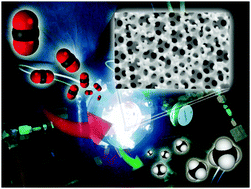当前位置:
X-MOL 学术
›
Energy Environ. Sci.
›
论文详情
Our official English website, www.x-mol.net, welcomes your feedback! (Note: you will need to create a separate account there.)
Enhanced photothermal reduction of gaseous CO2 over silicon photonic crystal supported ruthenium at ambient temperature†
Energy & Environmental Science ( IF 32.5 ) Pub Date : 2018-10-09 00:00:00 , DOI: 10.1039/c8ee02347f Paul G. O’Brien 1, 2, 3, 4 , Kulbir K. Ghuman 5, 6, 7, 8 , Abdinoor A. Jelle 3, 4, 9, 10 , Amit Sandhel 3, 4, 10, 11 , Thomas E. Wood 3, 4, 10, 12 , Joel Y. Y. Loh 3, 4, 10, 13 , Jia Jia 3, 4, 10, 11 , Doug Perovic 3, 4, 9, 10 , Chandra Veer Singh 3, 4, 9, 10 , Nazir P. Kherani 3, 4, 9, 10, 13 , Charles A. Mims 3, 4, 10, 12 , Geoffrey A. Ozin 3, 4, 10, 11
Energy & Environmental Science ( IF 32.5 ) Pub Date : 2018-10-09 00:00:00 , DOI: 10.1039/c8ee02347f Paul G. O’Brien 1, 2, 3, 4 , Kulbir K. Ghuman 5, 6, 7, 8 , Abdinoor A. Jelle 3, 4, 9, 10 , Amit Sandhel 3, 4, 10, 11 , Thomas E. Wood 3, 4, 10, 12 , Joel Y. Y. Loh 3, 4, 10, 13 , Jia Jia 3, 4, 10, 11 , Doug Perovic 3, 4, 9, 10 , Chandra Veer Singh 3, 4, 9, 10 , Nazir P. Kherani 3, 4, 9, 10, 13 , Charles A. Mims 3, 4, 10, 12 , Geoffrey A. Ozin 3, 4, 10, 11
Affiliation

|
Solar-driven CO2 hydrogenation can provide a renewable source of fuels and reduce greenhouse gas emissions if operated at industrial scales. Herein we investigate the photomethanation (light-driven Sabatier reaction) rates over Ru films sputtered onto silica opal (Ru/SiO2) and inverted silicon opal photonic crystal (Ru/i-Si-o) supports at ambient temperature under solar-simulated radiation as a function of incident light intensity. Photomethanation rates over both the Ru/SiO2 and Ru/i-Si-o catalysts increase significantly with increasing light intensity, and rates as large as 2.8 mmol g−1 h−1 are achieved over the Ru/i-Si-o catalyst. Furthermore, the quantum efficiency of the photomethanation reaction is almost three times larger when measured over the Ru/i-Si-o catalyst as compared to the Ru/SiO2 catalyst. The large photomethanation rates over the Ru/i-Si-o catalyst are attributed to its exceptional light-harvesting properties. Moreover, we perform DFT analysis to investigate the potential role of photo-induced charges on the Ru surface. The results from the simulation indicate that charged Ru surfaces can destabilize adsorbed CO2 molecules and adsorb and dissociate H2 such that it can readily react with CO2, thereby accelerating the Sabatier reaction.
中文翻译:

在环境温度下在硅光子晶体负载的钌上 增强了气态CO 2的光热还原†
如果以工业规模运行,太阳能驱动的CO 2加氢可以提供可再生燃料,并减少温室气体排放。在本文中,我们研究了在环境温度下在太阳模拟辐射下溅射到硅石蛋白石(Ru / SiO 2)和倒硅蛋白石光子晶体(Ru / i-Si-o)上的Ru膜上的光甲烷化(光驱动Sabatier反应)速率。作为入射光强度的函数。随着光强度的增加,Ru / SiO 2和Ru / i-Si-o催化剂上的光甲烷化速率均显着增加,且速率高达2.8 mmol g -1 h -1通过Ru / i-Si-o催化剂可实现。此外,当在Ru / i-Si-o催化剂上测量时,与Ru / SiO 2催化剂相比,光甲烷化反应的量子效率几乎大三倍。Ru / i-Si-o催化剂上较大的光甲烷化速率归因于其出色的光收集性能。此外,我们进行DFT分析以研究Ru表面上光诱导电荷的潜在作用。模拟的结果表明,带电的Ru表面可以使所吸附的CO 2分子不稳定,并吸附和离解H 2,从而使其易于与CO 2反应,从而加速了Sabatier反应。
更新日期:2018-10-09
中文翻译:

在环境温度下在硅光子晶体负载的钌上 增强了气态CO 2的光热还原†
如果以工业规模运行,太阳能驱动的CO 2加氢可以提供可再生燃料,并减少温室气体排放。在本文中,我们研究了在环境温度下在太阳模拟辐射下溅射到硅石蛋白石(Ru / SiO 2)和倒硅蛋白石光子晶体(Ru / i-Si-o)上的Ru膜上的光甲烷化(光驱动Sabatier反应)速率。作为入射光强度的函数。随着光强度的增加,Ru / SiO 2和Ru / i-Si-o催化剂上的光甲烷化速率均显着增加,且速率高达2.8 mmol g -1 h -1通过Ru / i-Si-o催化剂可实现。此外,当在Ru / i-Si-o催化剂上测量时,与Ru / SiO 2催化剂相比,光甲烷化反应的量子效率几乎大三倍。Ru / i-Si-o催化剂上较大的光甲烷化速率归因于其出色的光收集性能。此外,我们进行DFT分析以研究Ru表面上光诱导电荷的潜在作用。模拟的结果表明,带电的Ru表面可以使所吸附的CO 2分子不稳定,并吸附和离解H 2,从而使其易于与CO 2反应,从而加速了Sabatier反应。


























 京公网安备 11010802027423号
京公网安备 11010802027423号